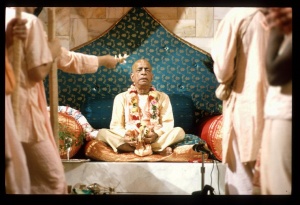CC Madhya 20.174 (1975): Difference between revisions
(Vanibot #0027: CCMirror - Mirror CC's 1996 edition to form a basis for 1975) |
(Vanibot #0020: VersionCompareLinker - added a link to the Version Compare feature) |
||
| Line 2: | Line 2: | ||
<div style="float:left">'''[[Sri Caitanya-caritamrta (1975)|Śrī Caitanya-caritāmṛta (1975)]] - [[CC Madhya (1975)|Madhya-līlā]] - [[CC Madhya 20 (1975)|Chapter 20: Lord Śrī Caitanya Mahāprabhu Instructs Sanātana Gosvāmī in the Science of the Absolute Truth]]'''</div> | <div style="float:left">'''[[Sri Caitanya-caritamrta (1975)|Śrī Caitanya-caritāmṛta (1975)]] - [[CC Madhya (1975)|Madhya-līlā]] - [[CC Madhya 20 (1975)|Chapter 20: Lord Śrī Caitanya Mahāprabhu Instructs Sanātana Gosvāmī in the Science of the Absolute Truth]]'''</div> | ||
<div style="float:right">[[File:Go-previous.png|link=CC Madhya 20.173 (1975)|Madhya-līlā 20.173]] '''[[CC Madhya 20.173 (1975)|Madhya-līlā 20.173]] - [[CC Madhya 20.175 (1975)|Madhya-līlā 20.175]]''' [[File:Go-next.png|link=CC Madhya 20.175 (1975)|Madhya-līlā 20.175]]</div> | <div style="float:right">[[File:Go-previous.png|link=CC Madhya 20.173 (1975)|Madhya-līlā 20.173]] '''[[CC Madhya 20.173 (1975)|Madhya-līlā 20.173]] - [[CC Madhya 20.175 (1975)|Madhya-līlā 20.175]]''' [[File:Go-next.png|link=CC Madhya 20.175 (1975)|Madhya-līlā 20.175]]</div> | ||
{{CompareVersions|CC|Madhya 20.174|CC 1975|CC 1996}} | |||
{{RandomImage}} | {{RandomImage}} | ||
==== TEXT 174 ==== | ==== TEXT 174 ==== | ||
<div class="verse"> | <div class="verse"> | ||
:vaibhava-prakāśa | :vaibhava-prakāśa kṛṣṇera--śrī-balarāma | ||
:varṇa-mātra-bheda, | :varṇa-mātra-bheda, saba--kṛṣṇera samāna | ||
</div> | </div> | ||
| Line 25: | Line 24: | ||
<div class="translation"> | <div class="translation"> | ||
"The first manifestation of the vaibhava feature of Kṛṣṇa is Śrī Balarāmajī. Śrī Balarāma and Kṛṣṇa have different bodily colors, but otherwise Śrī Balarāma is equal to Kṛṣṇa in all respects. | |||
</div> | </div> | ||
| Line 32: | Line 31: | ||
<div class="purport"> | <div class="purport"> | ||
To understand the difference between svayaṁ-rūpa, tad-ekātma-rūpa, āveśa, prābhava and vaibhava, Śrīla Bhaktivinoda Ṭhākura has given the following description. In the beginning, Kṛṣṇa has three bodily features: (1) svayaṁ-rūpa, as a cowherd boy in Vṛndāvana; (2) tad-ekātma-rūpa, which is divided into svāṁśaka and vilāsa; and (3) āveśa-rūpa. The svāṁśaka, or expansions of the personal potency, are (1) Kāraṇodakaśāyī, Garbhodakaśāyī, Kṣīrodakaśāyī and (2) incarnations such as the fish, tortoise, boar and Nṛsiṁha. The vilāsa-rūpa has a prābhava division, including Vāsudeva, Saṅkarṣaṇa, Pradyumna and Aniruddha. There is also a vaibhava division | To understand the difference between svayaṁ-rūpa, tad-ekātma-rūpa, āveśa, prābhava and vaibhava, Śrīla Bhaktivinoda Ṭhākura has given the following description. In the beginning, Kṛṣṇa has three bodily features: (1) svayaṁ-rūpa, as a cowherd boy in Vṛndāvana; (2) tad-ekātma-rūpa, which is divided into svāṁśaka and vilāsa; and (3) āveśa-rūpa. The svāṁśaka, or expansions of the personal potency, are (1) Kāraṇodakaśāyī, Garbhodakaśāyī, Kṣīrodakaśāyī and (2) incarnations such as the fish, tortoise, boar and Nṛsiṁha. The vilāsa-rūpa has a prābhava division, including Vāsudeva, Saṅkarṣaṇa, Pradyumna and Aniruddha. There is also a vaibhava division in which there are twenty-four forms, including the second Vāsudeva, Saṅkarṣaṇa, Pradyumna and Aniruddha. For each of these, there are three forms; therefore there are twelve forms altogether. These twelve forms constitute the predominant names for the twelve months of the year as well as the twelve tilaka marks on the body. Each of the four Personalities of Godhead expands into two other forms; thus there are eight forms, such as Puruṣottama, Acyuta, etc. The four forms (Vāsudeva, etc.), the twelve (Keśava, etc.), and the eight (Puruṣottama, etc.) all together constitute twenty-four forms. All the forms are differently named in accordance with the weapons They hold in Their four hands. | ||
</div> | </div> | ||
Latest revision as of 12:48, 27 January 2020

A.C. Bhaktivedanta Swami Prabhupada
TEXT 174
- vaibhava-prakāśa kṛṣṇera--śrī-balarāma
- varṇa-mātra-bheda, saba--kṛṣṇera samāna
SYNONYMS
vaibhava-prakāśa—manifestation of the vaibhava feature; kṛṣṇera—of Lord Kṛṣṇa; śrī-balarāma—Śrī Balarāma; varṇa-mātra—color only; bheda—difference; saba—everything; kṛṣṇera samāna—equal to Kṛṣṇa.
TRANSLATION
"The first manifestation of the vaibhava feature of Kṛṣṇa is Śrī Balarāmajī. Śrī Balarāma and Kṛṣṇa have different bodily colors, but otherwise Śrī Balarāma is equal to Kṛṣṇa in all respects.
PURPORT
To understand the difference between svayaṁ-rūpa, tad-ekātma-rūpa, āveśa, prābhava and vaibhava, Śrīla Bhaktivinoda Ṭhākura has given the following description. In the beginning, Kṛṣṇa has three bodily features: (1) svayaṁ-rūpa, as a cowherd boy in Vṛndāvana; (2) tad-ekātma-rūpa, which is divided into svāṁśaka and vilāsa; and (3) āveśa-rūpa. The svāṁśaka, or expansions of the personal potency, are (1) Kāraṇodakaśāyī, Garbhodakaśāyī, Kṣīrodakaśāyī and (2) incarnations such as the fish, tortoise, boar and Nṛsiṁha. The vilāsa-rūpa has a prābhava division, including Vāsudeva, Saṅkarṣaṇa, Pradyumna and Aniruddha. There is also a vaibhava division in which there are twenty-four forms, including the second Vāsudeva, Saṅkarṣaṇa, Pradyumna and Aniruddha. For each of these, there are three forms; therefore there are twelve forms altogether. These twelve forms constitute the predominant names for the twelve months of the year as well as the twelve tilaka marks on the body. Each of the four Personalities of Godhead expands into two other forms; thus there are eight forms, such as Puruṣottama, Acyuta, etc. The four forms (Vāsudeva, etc.), the twelve (Keśava, etc.), and the eight (Puruṣottama, etc.) all together constitute twenty-four forms. All the forms are differently named in accordance with the weapons They hold in Their four hands.